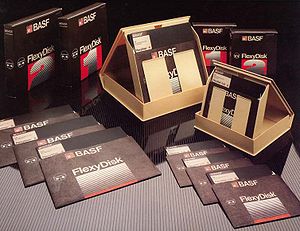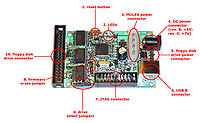Rescuing Floppy Disks
While they were cool-looking, convenient and even somewhat inexpensive after a while, Floppy Disks are out as a medium to store data on home computers. The USB stick, wireless access, the use of the internet, and a whole other range of options have rendered this medium obsolete. That said, a situation now exists where there are millions of these things out in the world, some of them containing rare or unusual pieces of history, and so there's a lot of benefit to getting all that old data off that medium.
This page is meant to be a clearinghouse for various options that a person or group of reasonable technical ability could use to rescue data from floppy disks. If any of these options seem daunting, a number of people have offered to accept floppy disks and pull the data using these tools.
None of these options should be considered endorsements, and Archive Team does not earn commission from the sale of these items.
Some Basic Thoughts on Floppy Disks
There are three different main sizes of floppy disks that had the most traction:
- 8" Disks
- 5 1/4" Disks
- 3 1/2" Disks
8" floppies fell out of favor relatively quickly in favor of the 5 1/4" versions. In the late 1980s, 3 1/2" overtook 5 1/4" as the dominant format, but a lot of machines, such as the Commodore 64, Atari 810, IBM PC, Kaypro, Apple II and II, and a range of others all supported the 5 1/4" primarily.
All floppies work on the same principle: a magnetic disc with a hole in the middle is inside a case, and a disk drive reads the magnetic data off the disc. Some aspects changed - where 8" and 5 1/4" discs had no built-in protection for the magnetic face of the disc except a paper cover, the 3 1/2" versions had a small spring-loaded door that was opened by the disk drive.
Storage could make a huge difference in the lifespan of Floppies, and a pile of disks put inside a box that was stored in a low humidity, non-extreme-temperature environment could last a lot longer than a floppy used constantly that was left on top of a computer monitor for weeks.
We're going to assume you're just trying to take a pile of disks from however far back and transfer the data onto something more recent. In all cases, try and avoid throwing out the original disks after doing transfer, as you might find that the transfer you've done is missing information, or that technology might have shifted in the meantime, allowing better extraction of the data.
Methods of Transfer (Hardware)
There are currently multiple ways to transfer a lot of floppy disks, some involving original hardware and others involving customized circuits to use modern hardware to pull the data off the disk.
Kryo-Flux
Currently, the most hard-core approach is the use of a device called a Kryo-flux connected to a modern floppy drive (3.5" or 5.25"). This hardware solution utilizes a floppy head to read a floppy disk not as a bunch of data but the actual magnetic flux of the disks themselves. What this translates to, in the vast majority of cases, is a disk image that includes any copy protection, unusual write schemes, or trickery. Naturally it captures the full data of the disk as well, and this is likely overkill if you're digitizing a personal set of files stored on an item, but it's good to know the option is there. Kryoflux boards are for sale at the Kryoflux site.
FC-5025
A slightly less expensive and more directed version is the FC-5025, from Device Side Data. Also consisting of a circuit board with USB and floppy drive connectors, this hardware can read a certain number of disks as well, although there are some disk variations it can't.
ZoomFloppy (C-64 Only)
If you're looking to duplicate just disks for the Commodore 64, the ZoomFloppy from RETRO Innovations will allow you to do so with an original 1541 (and compatibles), 1571 or 1581 disk drive, and plug it via this card into your Windows, Unix, or Mac OSX system. As an extra bonus, it'll allow you to hook up commodore printers to your modern machine, just in case you were looking for that.
SIO2PC (Atari Only)
The SIO2PC allows your Atari 800, 130XE, etc to see a PC as another floppy disk drive, making it easy to copy floppies to it, as well as providing a handy way to run your Atari without using a floppy drive. They can be bought various places like AtariMax or you can build your own from the original schematics.
Methods of Transfer (Volunteers)
If you're interested in volunteering to transfer disks for people, please put your information here.
Gene Buckle - geneb@deltasoft.com I can process Apple II & IIgs disks in 5.25" and 3.5" sizes as well as the Commodore 8 bit media (1541, 1571, 1581). I can also image most 5.25" CP/M formatted disks.
Some Links
- A Review of the FC5025 by Jason Scott
- The Kryoflux Product Page
- ZoomFloppy Product Page
- ZoomFloppy: First Impressions by Rob O'Hara
- A Sad Day for Floppy Disks by Rob O'Hara
- The Software Preservation Society (Makers of Kryoflux)

